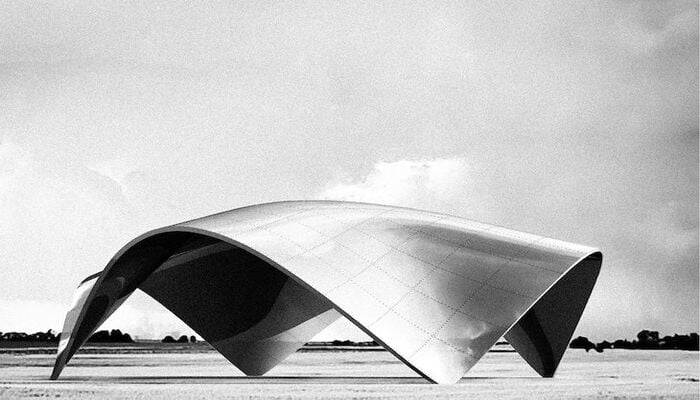21 Most Impressive Bridges in the World 2025
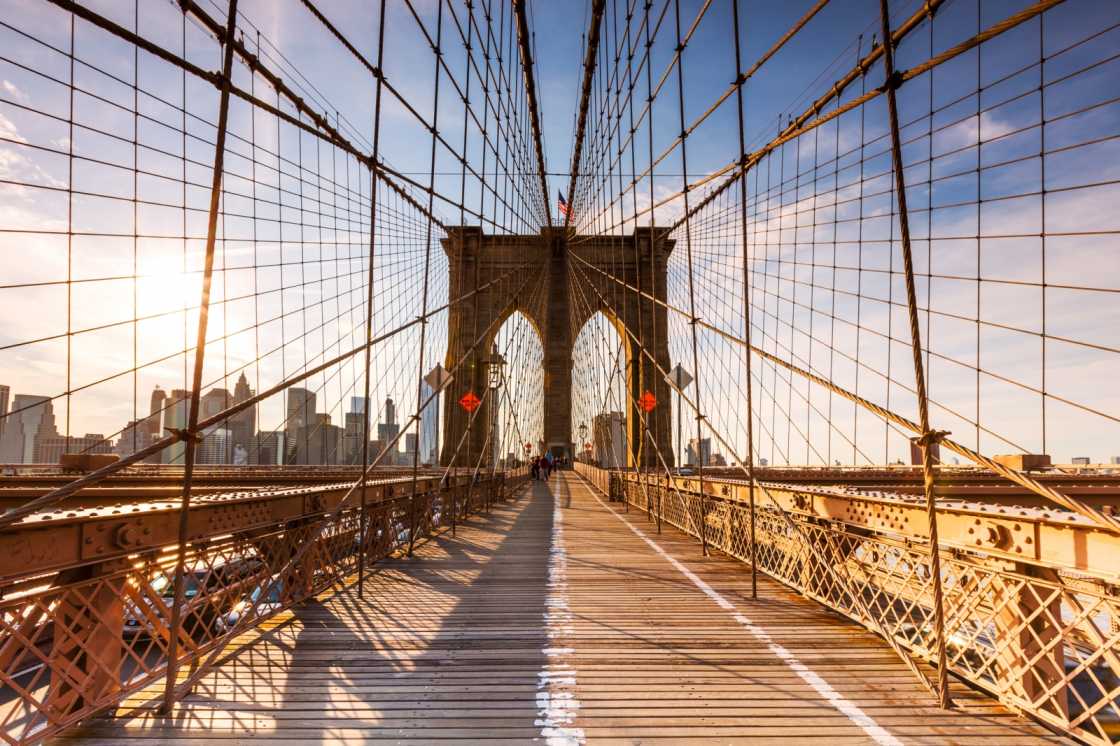
Table of Contents
Throughout history, bridges have had a profound impact on the way people move in their territories near and far to establish interactions with each other. Before these connecting structures came into existence, explorations that involved crossing a river or a deep ravine were considered to be dangerous and time-consuming, limiting people’s ability to trade or travel. Bridges have made it easier to cross such barriers and allowed humans to expand their horizons of settlements and trade.
In this blog, we will learn about the various types of bridges and the top 21 most beautiful bridges in the world.
Types of Bridges
Did you know that there are many different types of bridges, each with its unique design, engineering and construction methods? Let’s learn about them!
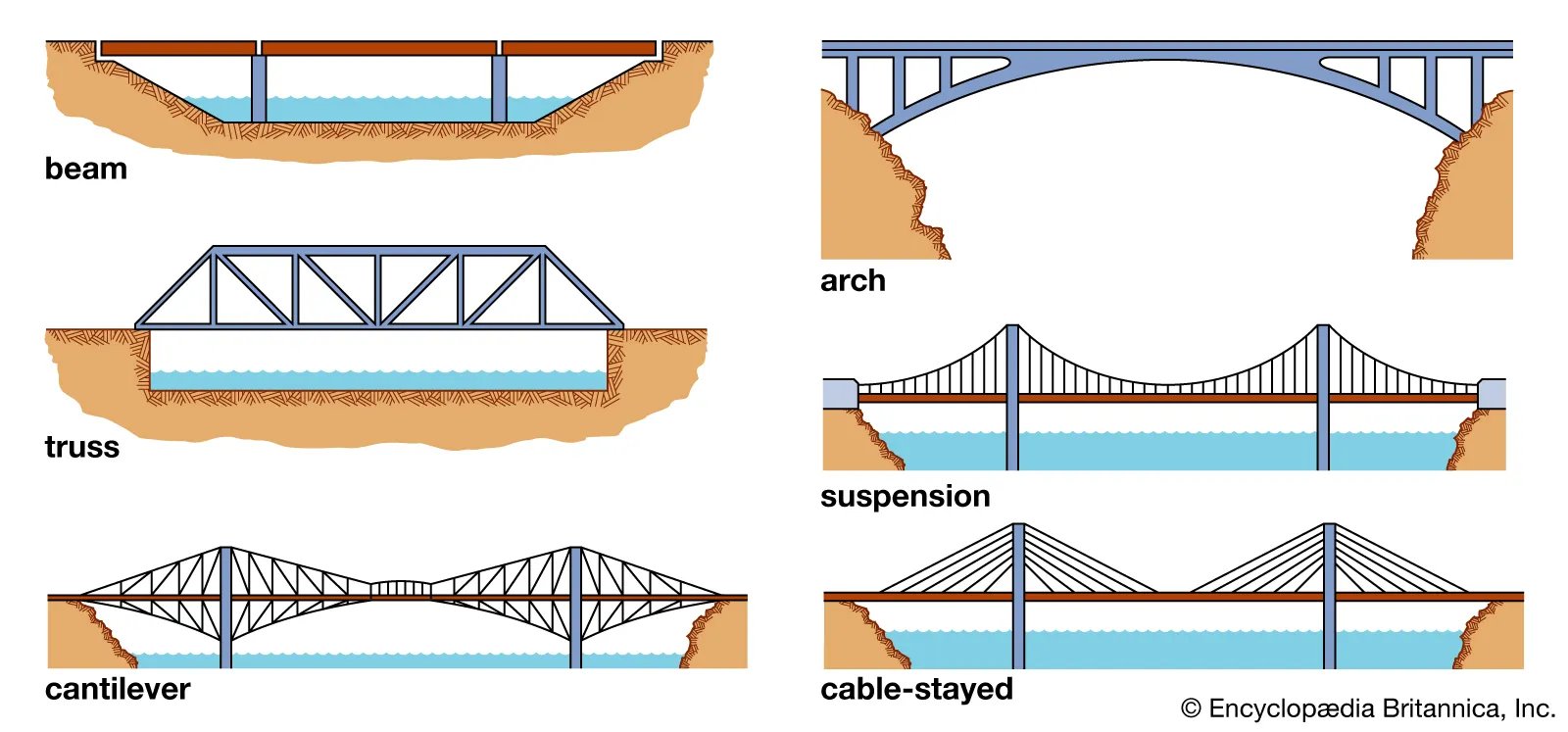 Different Types of Bridges
Different Types of Bridges
- Beam Bridges: Beam bridges are simple and common bridge structures supported by horizontal beams stretching across two or more supports.
- Arch Bridges: These bridge structures use arches to support the bridge's weight and the load on it.
- Tied-arch bridges: These are bridge structures that support the bridge's weight and the load on it by using a curved arch tied down by vertical braces.
- Suspension Bridges: These long-span bridge structures are supported by cables suspended from towers, with the weight of the bridge and load on it transferred to anchorages at either end of the bridge.
- Cable-stayed Bridges: In these bridges, the cables are attached to the towers which alone bear the load.
- Truss Bridges: Truss bridges are bridge structures that use a series of interconnected trusses to distribute the bridge's weight and the load on it.
- Cantilever Bridges: Cantilever bridges are bridge structures that support the weight of the bridge and the load on it by using cantilevers.
- Movable Bridges: Movable bridges are bridge structures that can be opened, closed, or raised to allow boats and ships to pass underneath.
Most Impressive Bridges in the World
From the iconic Golden Gate Bridge to the stunning Millau Viaduct, how bridges are designed can help place the locations on the global map, piquing the interest of visitors. Let us take a journey across the globe to discover the engineering and design innovations that have made these bridges not only functional but also beautiful landmarks that inspire admiration.
1. Helix Bridge, Singapore

Designers: Cox Architecture + Architects 61 + Arup Engineers
Type: Cable-stayed Bridge
Length: 2,460 meters
Location: Connecting Marina Centre and Marina South
The Helix Bridge is a famous bridge that showcases impressive engineering and design.Inspired by the double helix of DNA, it reflects Singapore's interconnectedness. Sustainability was prioritized through the utilization of Building Information Modelling (BIM) technology and GenerativeComponents (GC), to streamline construction and reduce material usage. The bridge predominantly employs steel, using only one-fifth of the steel required for a conventional bridge of similar length.
2. Golden Gate Bridge, United States

Designers: Joseph B.Strauss
Type: Suspension Bridge
Length: 2,737 meters
Located Between the San Francisco Peninsula and the Marin Headlands of California
The iconic Golden Bridge represents America's power and progress. Designed as a resilient suspension bridge, it can withstand high winds and earthquakes. Two towers are linked by main cables containing around 27,000 individual wires. The bridge's distinctive orange-red hue radiates a golden glow, mirroring the waters of the Golden Gate Strait. Currently, BIM technology is employed to create a digital model, facilitating maintenance and repair planning for the bridge.
3. Millau Viaduct Bridge, France
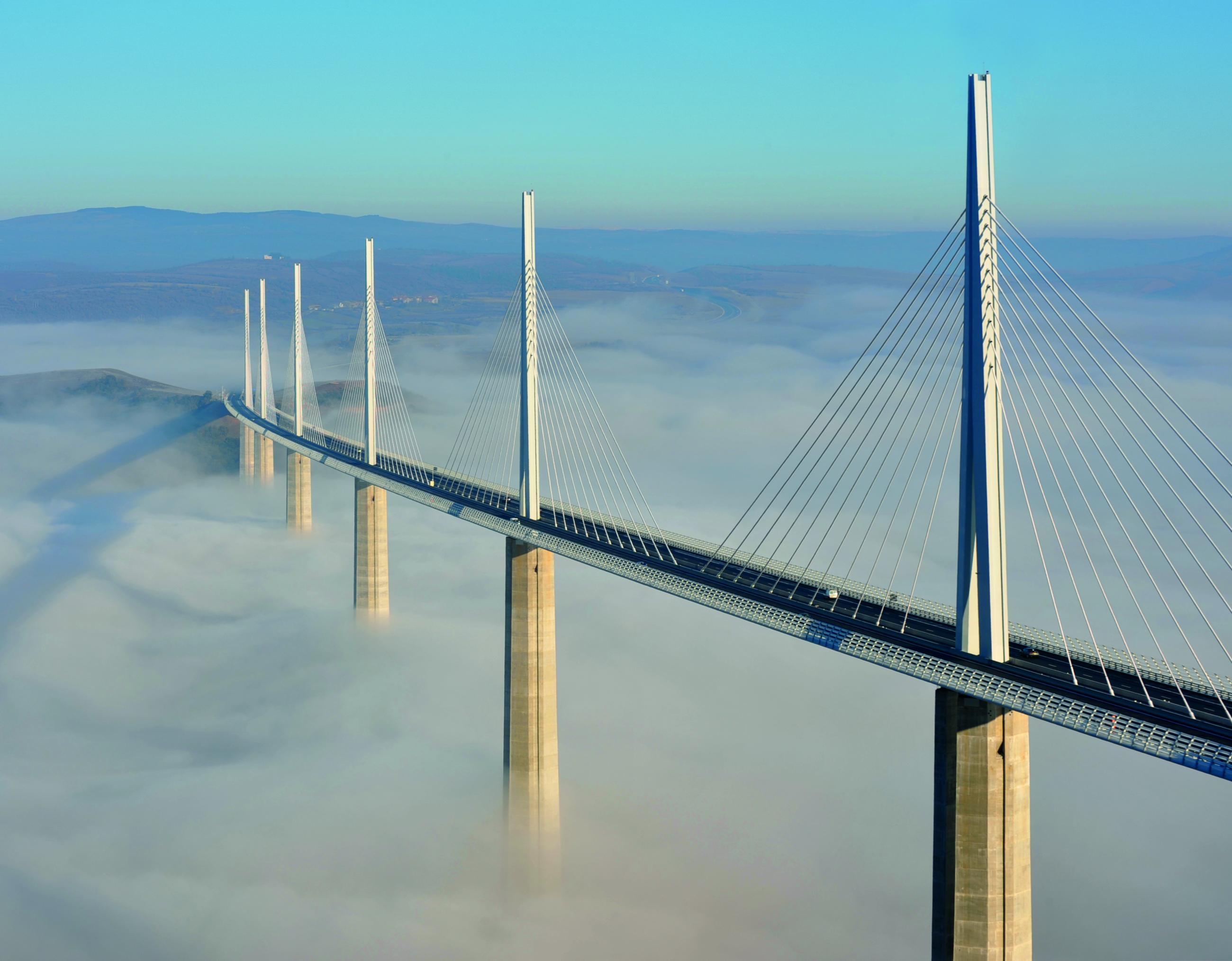
Designers: Norman Foster and Michel Virlogeux
Type: Cable-stayed Bridge
Length: 2,460 meters
Location: Tarn River Valley of France
The design of such a magnificent structure, in terms of aesthetics and technical aspects, required a lot of brainstorming from the designers and engineers. It was made possible by their unrivaled coordination. Lightweight concrete has been used to design the Millau Viaduct Bridge’s deck and steel and concrete have been used in the supporting towers. While being a lightweight bridge, this structure stands strong against the winds and seismic vibrations making it one of the best bridges in the world.
Read more: Why Doesn't Europe Support the Construction of High-Rise Buildings?
4. Tower Bridge, United Kingdom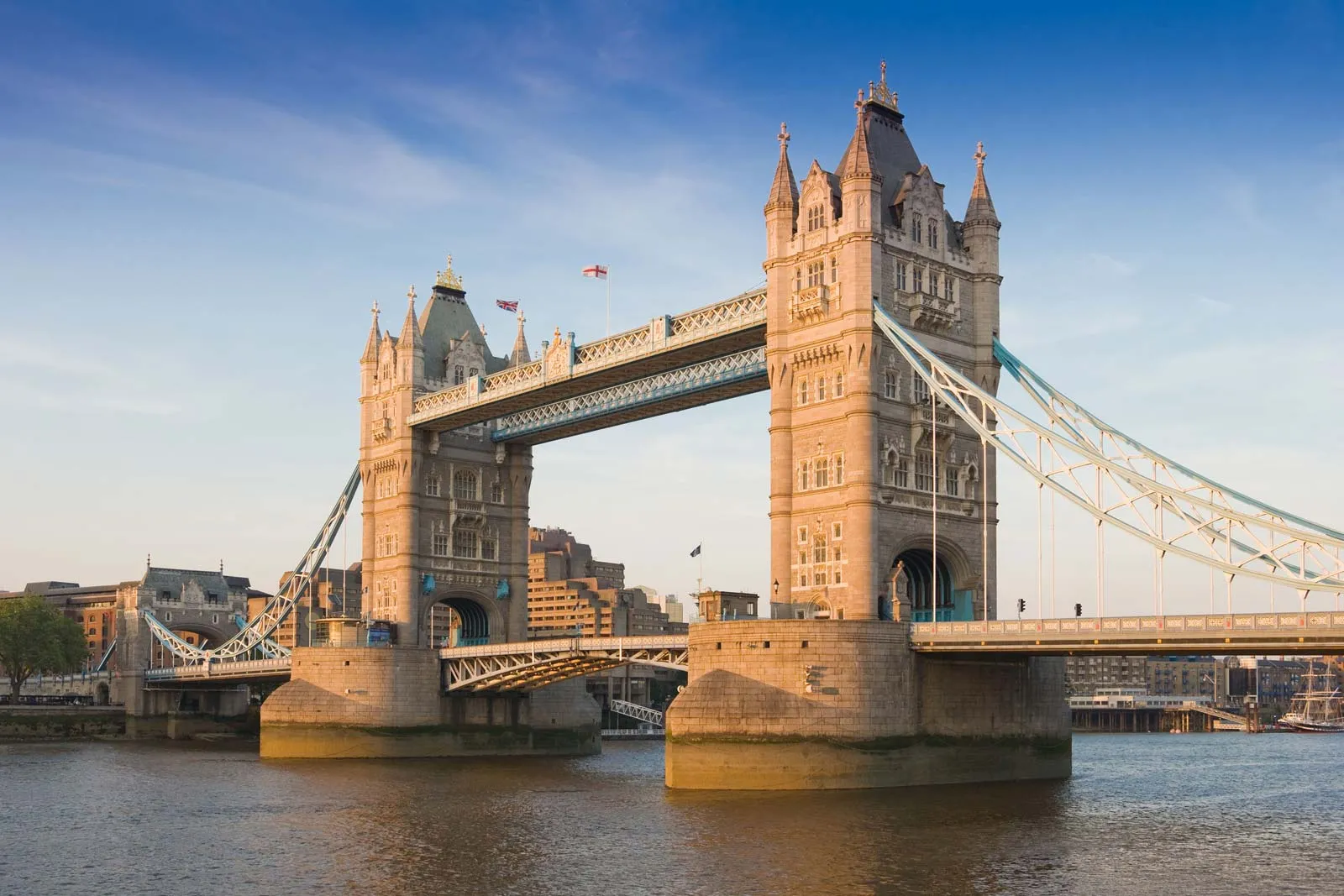
Designers: Horace Jones, John Wolfe Sir Barry, George D. Stevenson
Type: Suspension Bridge
Length: 269 meters
Location: London, City of London, Southwark, Central London, SE postcode area
Tower Bridge is one of the essential and iconic symbols of London, also famous as the greatest bridge in the world, combining both bascule (drawbridge) and suspension bridge elements. Opened in 1973, it features two massive towers connected by walkways and a central section that can be raised to allow ships to pass through. The bridge's intricate Gothic-style architecture and Victorian engineering make it a must-visit attraction for tourists and locals alike. The architecture and materials used to build this bridge make it one of the strongest bridge designs.
5. Brooklyn Bridge, United States

Designers: John Roebling
Type: Suspension Bridge
Length: 1825 meters
Location: Across the East River of New York connecting Manhattan and Brooklyn
Inspired by the 19th-century Gothic Revival Style, the bridge was constructed in the 1880s, showcasing the pioneering use of steel as a building material, which also places it as one of the best bridges in the world. The cable design ingeniously intertwines steel wires, ensuring both flexibility and balanced load distribution. Preservation initiatives prioritize leveraging BIM technology to effectively rehabilitate and maintain this historically significant structure, safeguarding its safety, functionality, and rich heritage for future generations to appreciate and admire.
6. Ruyi Bridge, China

Designers: He Yunchang
Type: Cable-stayed Bridge
Length: 2,234 meters
Location: Shenxianju Valley (Zhejiang, China)
Designed by He Yunchang, this remarkable structure is a perfect example of a modern bridges that rises 140 meters above Shenxianju Valley, featuring three wavy pedestrian bridges with glass decks. Inspired by the auspicious ruyi symbol, it embodies good luck. The bridge integrates a rainwater harvesting system for eco-conscious landscaping and irrigation. With energy-efficient LED lighting and the use of sustainable materials, it exemplifies a commitment to environmental sustainability.

7. Sydney Harbour Bridge, Australia

Designers: Dorman Long and Co Ltd
Type: Tied Arch Bridge
Length: 1149 meters
Location: Connecting Sydney CBD to North Sydney
The Sydney Harbour Bridge employs a unique cantilever method developed exclusively for the project, eliminating the need for temporary support. A specially designed cantilever supported the structure during construction, reducing time and costs. This is one of the modern bridges that features a distinctive. At night, a vibrant lighting system illuminates the bridge, adding to its allure as a popular tourist attraction, making it one of the best bridges in the world.
8. Millennium Bridge, United Kingdom

Designers: WilkinsonEyre Architects
Type: Tied Arch Movable Bridge
Length: 126 meters
Location: Across River Tyne in Northeast England (Between Gateshead and Newcastle)
The Millenium Bridge, completed in 2001 for Tyne Riverfront rejuvenation, can impressively tilt up to a 40-degree angle to accommodate large vessels. Its hydraulic rams and computer-controlled system ensure smooth movement. BIM technology facilitated a detailed bridge model for structural analysis, design exploration, and efficient coordination among construction teams. BIM proved essential in planning, managing contractors, and real-time project tracking, enhancing the construction process for this iconic structure.
9. Zaragoza Bridge Pavilion, Spain

Designers: Zaha Hadid Architects
Type: Beam Bridge
Length: 270 meters
Location: Across the River Ebro in Zaragoza
Zaragoza Bridge, designed by Zaha Hadid Architects, highlights water's significance in sustainable development. The pavilion's flowing shape is achieved with curved steel frames and a translucent fabric membrane. Internally, exhibition spaces explore water and sustainability. Computational design and BIM are used to optimize its parametric geometry, ensuring structural efficiency. BIM simulations also analyze its performance under various conditions, enhancing design quality.
Read more: 7 Most Common Types of Building Simulations in Architecture to Achieve Sustainable Design
10. Akashi Kaikyo Bridge, Japan

Designers: Honshu-Shikoku Bridge Authority (HSBA) + Satoshi Kashima
Type: Suspension Bridge
Length: 3911 meters
Location: Between Kobe City and Iwaya of Awaji Island
The Akashi Kaikyo Bridge has two main towers that stand at a height of 297 meters above sea level. Its deck is supported by a stiffening truss which is a lattice-like structure that distributes the weight of the bridge evenly across the two towers. This truss also helps the bridge to withstand strong winds and earthquakes. BIM technology was used in its structural analysis and construction and is still being used in its ongoing maintenance. All of these features make it one of the best bridges in the world.
11. The Root Bridges, India

Type: Suspension Bridge
Length: ~50 metres
Location: Villages of Cherrapunji Meghalaya
The awe-inspiring root bridges, nurtured by nature itself, are formed by living tree roots intertwining over water. Situated near Shillong, these bridges have been meticulously crafted by locals for over 10-15 years using tree trunks and temporary scaffolding. Unlike conventional structures, these organic marvels withstand time's trials and gain strength as they age, enduring for centuries. Engineered materials such as concrete and steel are absent, showcasing the power of nature's engineering prowess and placing it as one of the best bridges in the world.
12. Puente de la Mujer, Argentina
.png?width=809&height=535&name=Screenshot%20(80).png)
Designers: Santiago Calatrava
Type: Arch Bridge
Length: 102 meters
Location: Buenos Aires, Argentina
In the late 1980s, Buenos Aires revitalized Puerto Madero's neglected port area with the Puente de la Mujer. This 102-meter rotating suspension bridge features a 39-meter-high inclined pylon supporting the central section. Made of concrete and steel, the bridge's timber-clad deck offers accessibility for both pedestrians and cyclists. It illuminates at night as a symbol of Puerto Madero's transformation, placing it as one of the best bridges in the world.
13. Sheikh Zayed Bridge, United Arab Emirates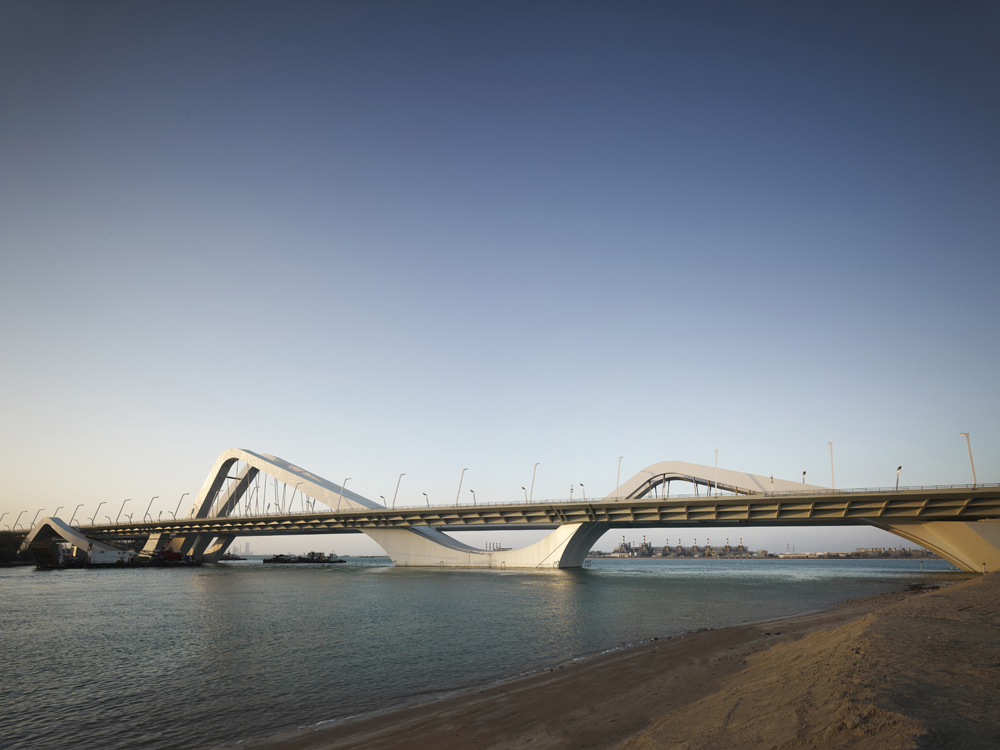
Designers: Zaha Hadid Architects
Type: Arch bridge
Length: 842 meters
Location: UAE connecting Abu Dhabi and Saadiyat islands across the Maqta Channel
The Python Bridge, also known as High Bridge, stands out as one of the best bridges in the world, with its wavy shape and vibrant red color. Spanning a 90-meter canal in Amsterdam's Eastern Docklands, it connects Sporenburg to Borneo Island. Designed by Adriaan Geuze, this award-winning bridge blends technology and artistry, allowing smooth passage for tall ships. Its crimson-threaded railings add visual allure. While being nestled in a serene neighborhood, it enthralls tourists and design enthusiasts with its innovative design.
14. Henderson Waves Bridge, Singapore

Designers: RSP Architects Planners & Engineers Pte Ltd
Type: Cantilever Bridge
Length: 274 meters
Location: Spans the Henderson Road connecting Mount Faber Park to Telok Blangah Hill Park
The Henderson Waves bridge is an integral part of a larger leisure destination in southern Singapore, connecting hills, parks, and attractions. Designed with an environmentally responsible approach, it seamlessly blends into its surroundings, making it one of the best bridges in the world. Inspired by maths, its unique folded form creates an undulating structure. The bridge offers alcoves, benches, and a wide walkway, prioritizing sustainability. As an iconic landmark, it rejuvenates hill parks and provides new ways to experience nature.
15. Seven Mile Bridge, United States

Designers: Henry Flagler and William Krome (Original Architects), Figg Engineering Group (New Architects)
Type: Beam Bridge
Length: 11,000 meters
Location: Spans across Florida Keys (a string of Tropical Islands) connecting Knight's Key to Little Duck Key
The Seven Mile Bridge in the Florida Keys is a remarkable concrete segmental box girder bridge. Built using precast concrete segments, it ensures efficiency and strength. Multiple segments form a durable deck, enabling the bridge to withstand challenges and provide reliable transportation. This construction technique showcases the application of segmental methods in bridge engineering, ensuring longevity and functionality.
Read more: List of Top Fabrication Materials to Use in the Construction Industry Today
16. Laguna Garzon Bridge, Uruguay

Designers: Rafael Viñoly
Type: Beam Bridge
Length: 323 meters
Location: Spans the Laguna Garzón lagoon, linking the towns of Rocha and José Ignacio
The Laguna Garzon Bridge in Uruguay features a unique circular shape, prioritizing pedestrian safety and connecting the Rocha and Maldonado Departments. Architect Rafael Viñoly's design promotes controlled traffic flow, enhancing pedestrian safety, and making it one of the best bridges in the world. This architectural landmark merges functionality and aesthetics, offering a visually striking structure that enhances transportation. The bridge symbolizes Uruguay's commitment to innovative design and showcases the country's architectural prowess.
17. Pont du Gard, France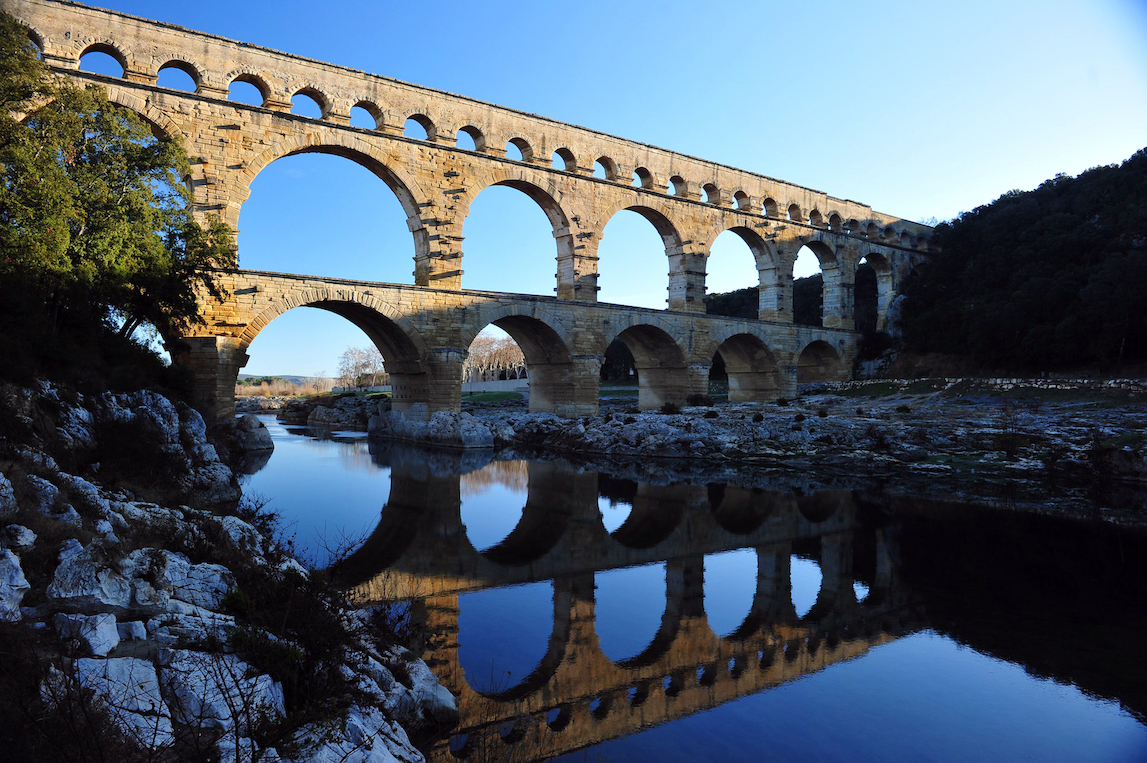
Designers: Marcus Vipsanius Agrippa
Type: Arch bridge
Length: 275 meters
Location: Vers-Pont-du-Gard in Southern France
The Pont du Gard is an ancient Roman aqueduct bridge that spans the Gardon River in southern France. It was built in the 1st century AD, it served as part of a larger aqueduct system that supplied water to the city of Nîmes. The bridge's three tiers of arches, constructed without the use of mortar, are proof to the engineering prowess of the Roman Empire and continue to attract visitors from around the world.
18. Hangzhou Bay Bridge, China
bridges-architectural-wonders-around-the-world-hangzhou-bay-bridge-china.jpg?width=806&height=505&name=(engineersdaily.com)bridges-architectural-wonders-around-the-world-hangzhou-bay-bridge-china.jpg)
Designers: Stefano Boeri Architetti
Type: Cable-stayed Bridge
Length: 35700 metres
Location: Between cities of Shanghai and Ningbo
Over ten years, a team of over 600 experts meticulously designed the Hangzhou Bay Bridge, employing cable-stayed techniques to withstand demanding conditions including tidal forces, earthquakes, and strong winds. The decision to use corrosion-resistant steel piles instead of concrete further enhanced its durability making it one of the best bridges in the world. Additionally, innovative methods such as the utilization of large cranes for precise girder placement played a crucial role in ensuring the bridge's successful construction and long-term resilience.
19. Cirkelbroen Bridge, Denmark

Designers: Studio Olafur Eliasson
Type: Cable-stayed Bridge
Length: 40 meters
Location: Copenhagen, Denmark
The Cirkelbroen Bridge in Copenhagen, envisioned by artist Olafur Eliasson, connects the port area while creating a space for gathering and interaction. Its sailboat-inspired design comprises five circular platforms with distinct "masts" arranged in a staggered formation. This innovative approach combines functionality with visual allure, fostering a sense of community and fostering relationships among users. The bridge stands as a testament to the harmonious integration of art and infrastructure, enhancing the urban experience, and making it one of the best bridges in the world.
20. Pucol Arch Bridge, Spain

Designers: FVAI Estructuras Arquitecturas
Type: Arch Bridge
Length: 30 meters
Location: Region of Pucol
The Puçol Arch bridge in Valencia improves daily routes for residents and addresses economic considerations, benefiting the community as a whole. This bridge connects the divided town, providing a crucial link for pedestrians and vehicles. It eases traffic congestion by offering an alternative route from the highway to the industrial estate, bypassing the town center. The design emphasizes functionality, durability, and stability while integrating harmoniously with the surrounding landscape, making it one of the best bridges in the world.
21. Skybridge Michigan, United States of America

Designers: Experiential Resources ("ERi")
Type: Suspension Bridge
Length: 340 meters
Location: Spans Boyne Valley in Michigan
Known as "Michigan's Second Bridge", SkyBridge Michigan was inspired by the logging heritage of northern Michigan. The bridge features timber sourced from a local family-owned logging and sawmill company. The towers stand tall at 52 feet, and the bridge has a spacious walking deck with a section of structural glass offering captivating views. Opened in October 2022, SkyBridge Michigan provides a new and exciting adventure for visitors, allowing them to enjoy the panoramic vistas of northern Michigan.
Conclusion
Bridges are among the most significant and impressive architectural structures in the world. They come in a variety of shapes and sizes and serve a variety of functions, including providing vital transportation links across rivers and valleys as well as serving as iconic landmarks and tourist attractions. Through the examples, we can conclude that these structures are designed and constructed mindfully, most of which have used BIM in their construction and still use it in their maintenance, making them symbols of the world coming together.
Want to learn how to design amazing bridges like these?
Explore the BIM Professional Course offered by Novatr. This course helps you understand the subject theory, master advanced tools, and build your expertise. The course helps you:
- Become a BIM expert in just 7 months of part-time, online study.
- Master 15+ BIM software and industry workflows.
- Learn from AEC professionals leading BIM at top-tier firms worldwide.
- Work on a live, RIBA-structured capstone project to practice your skills.
- Get placement assistance to land jobs in globally operating BIM firms.
Get your hands on BIM so you can design these strong structures with ease.
Frequently Asked Questions:
1. Which bridge is the most beautiful in the world?
It is hard to assume the most beautiful bridge in the world as it is subjective. However, the Golden Gate Bridge in San Francisco, USA, and the Millau Viaduct in France are frequently celebrated for their architectural elegance and aesthetic appeal.
2. What are the top 5 famous bridges in India?
India boasts several iconic bridges showcasing its engineering achievements and cultural heritage.
-
The Howrah Bridge in Kolkata, inaugurated in 1943, is a bridge spanning the Hooghly River, serving as a vital link between Kolkata and Howrah.
-
The Bandra–Worli Sea Link in Mumbai, opened in 2009, is a cable-stayed bridge that has become a modern architectural landmark in the city.
-
Vidyasagar Setu, also known as the Second Hooghly Bridge, completed in 1992, is another significant cable-stayed bridge in Kolkata, enhancing connectivity over the Hooghly River.
-
The Pamban Bridge in Tamil Nadu, inaugurated in 1914, was India's first sea bridge, connecting the town of Mandapam with Rameswaram Island.
-
Mahatma Gandhi Setu in Bihar opened in 1982, spans the Ganges River, linking Patna and Hajipur, and was once the longest river bridge in India.
3. What are the top 5 highest bridges in the world?
The world's highest bridges, measured by the height of their decks above the ground or water below, are engineering marvels that showcase human ingenuity.
-
The Duge Bridge in China, completed in 2016, holds the current record, with its deck towering approximately 565 meters (1,854 feet) above the Beipan River.
-
The Siduhe Bridge, also in China, has a deck height of about 496 meters (1,627 feet).
-
The Puli Bridge, another Chinese feat, stands with a deck height of 485 meters (1,591 feet).
-
The Yavuz Sultan Selim Bridge in Turkey features a deck height of 322 meters (1,056 feet), making it one of the tallest bridges outside of China.
-
The Royal Gorge Bridge in the United States, completed in 1929, has a deck height of 291 meters (955 feet) and was the world's highest bridge until 2001.
Where is Asia's highest bridge?
Asia's highest bridge is the Duge Bridge, also known as the Beipanjiang Bridge, located on the border between Guizhou and Yunnan provinces in China. Completed in 2016, this engineering marvel spans the Nizhu River Gorge.

 Thanks for connecting!
Thanks for connecting!
.png)

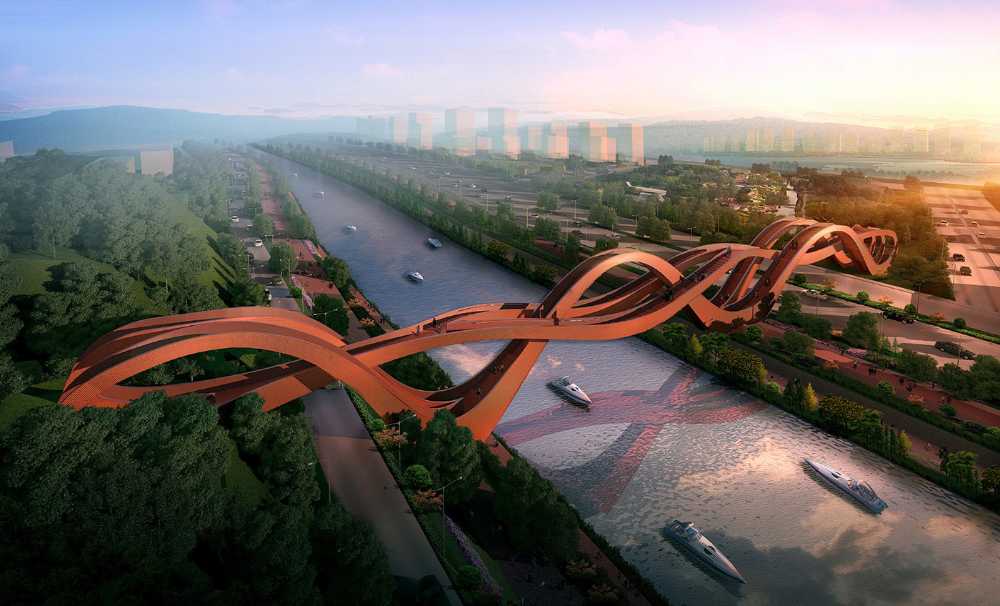

-1.png)
